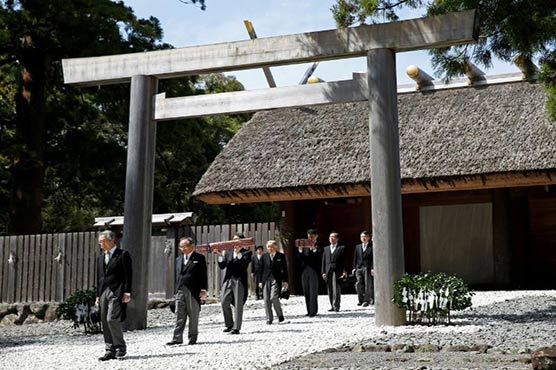Factbox - Japan's 'Three Sacred Treasures' symbolise emperor's legitimacy

The regalia - a sword, a mirror and a jewel - symbolise the legitimacy of the emperor.
TOKYO (Reuters) - When Crown Prince Naruhito succeeds his father as Japan’s new emperor on Wednesday, he will receive the “Three Sacred Treasures” that seal his accession to the Chrysanthemum Throne.
The regalia - a sword, a mirror and a jewel - symbolise the legitimacy of the emperor.
They are so crucial to the royal family that Naruhito’s grandfather, Emperor Hirohito, said that protecting them was a factor in his decision to surrender in World War Two.
Here are details about the treasures:
MYTHICAL ORIGIN
According to Japanese mythology, a mirror and a jewel were used to lure the sun goddess Amaterasu Omikami from the cave where she had withdrawn, plunging the world into darkness.
Later, the goddess granted to her grandson, Ninigi-no-Mikoto, the mirror and jewel as well as a sword that had been found in the body of an eight-headed serpent when she sent him to earth to rule Japan.
Legend has it the treasures were passed down to Ninigi-no-Mikoto’s great-grandson, Jimmu, Japan’s first emperor. An eighth-century chronicle says Jimmu became emperor in the 7th century B.C., but there is doubt as to whether he ever existed.
WHERE ARE THEY?
The mirror, called Yata-no-Kagami, is kept at the Ise Grand Shrine, the holiest site in Japan’s Shinto religion. The sword, Kusanagi-no-Tsurugi, is stored at the Atsuta Shrine.
Both are in central Japan.
The third treasure, a jewel called Yasakani-no-Magatama, is stored at the Imperial Palace.
At Wednesday’s ceremony, the new emperor will be presented with the jewel and a sword representing the original relic kept at the Atsuta Shrine. The mirror is not present at the ceremony but is inherited by the emperor as part of the royal succession.
WHAT DO THEY LOOK LIKE?
As sacred objects, the treasures are always encased in boxes and cannot be seen by anyone, including the emperor.
Palace officials and scholars cannot see them either, so nobody knows exactly what they look like, experts say.
Ancient records refer to one emperor who tried to open the box containing the jewel. White smoke came out and the terrified emperor ordered his aide to close it.
However, experts have drawn clues from unearthed mirrors made in the 4th and 5th centuries, when ancestors of the emperor were gaining power in Japan.
The mirror is probably made of bronze, with intricate designs engraved on one side, and bigger than typical ancient mirrors excavated, which are 20-30 cm (8-12 inches) in diameter, said Naoya Kase, an associate professor at Kokugakuin University.
The jewel probably comprises of a number of comma-shaped beads used as accessories and ceremonial objects in ancient times, likely red in colour, Kase said.
The sword was probably not ornamental, but a practical weapon with an iron blade, he said.
EMPEROR’S DECISION
Emperor Hirohito said that in addition to stopping further bloodshed, his desire to keep the three treasures from falling into enemy hands was a factor in his decision to surrender in World War Two, according to an interview conducted by his aides in 1946 and published in 1990.
“If the enemy had landed near the Bay of Ise, both the Ise Grand Shrine and Atsuta Shrine would have been put under enemy control immediately, without any chance of us moving the sacred treasures away,” Hirohito was quoted as saying.
“I found it necessary to seek peace even at the sacrifice of myself,” he said.


